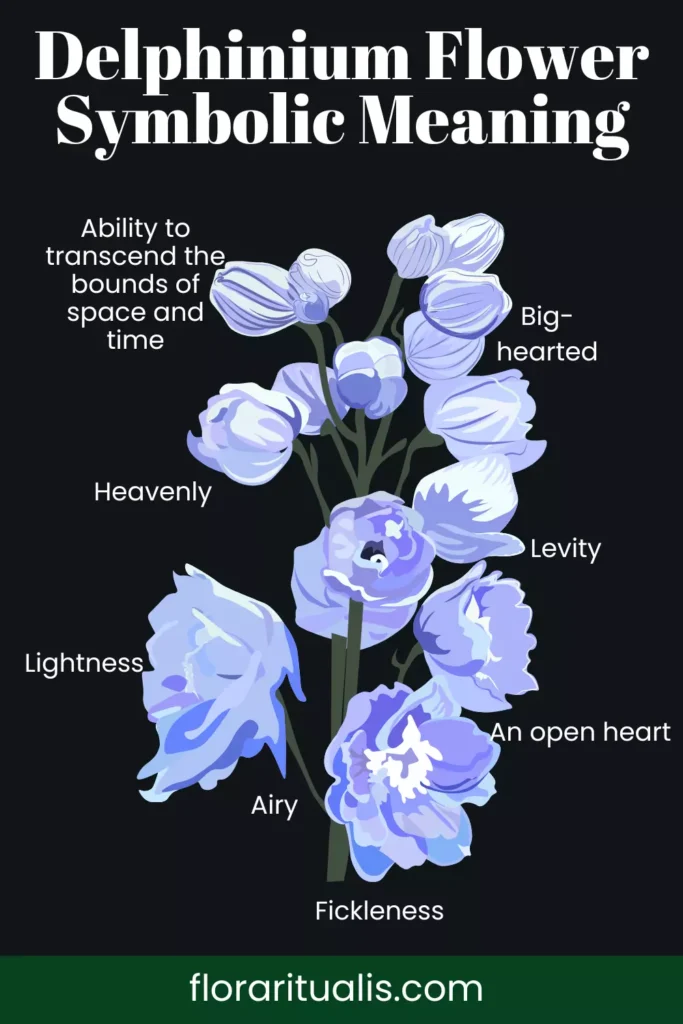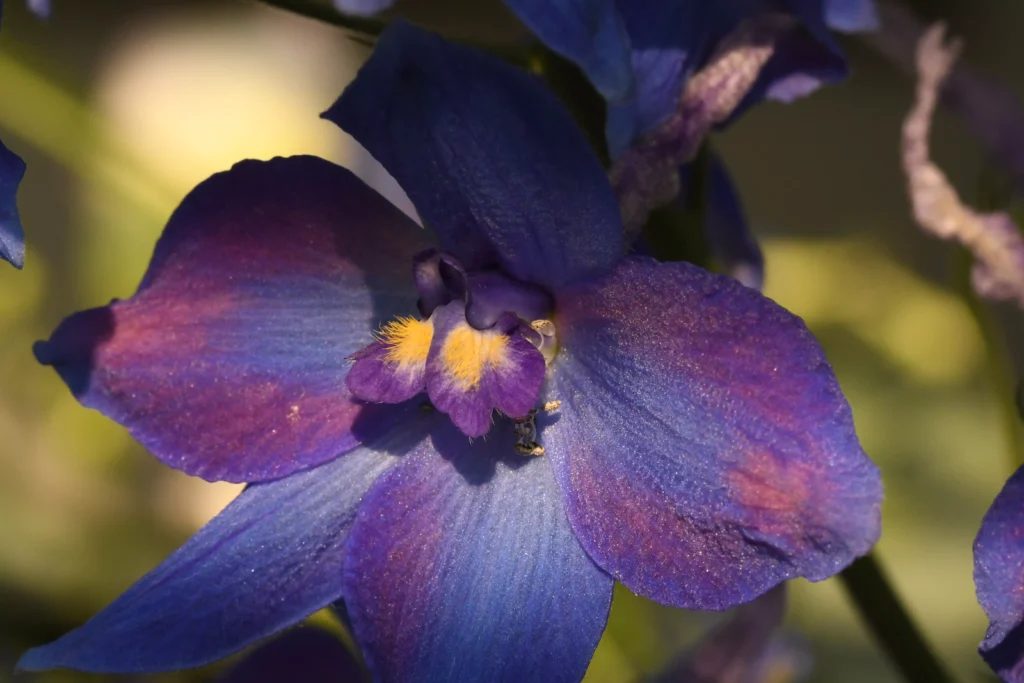The Delphinium flower meaning comes its myth, history and uses. You can find those flowers in bloom during early or late summer and sometimes during early fall.
This flower is often confused with the larkspur flower since they are both similar in appearance.
In this blog we will explore both the Delphinium and Larkspur flower. We will discover their meanings, how they are similar and also different from each other.
What does the delphinium flower symbolise?
The Delphinium flower or Little Larkspur symbolises the ability to transcend the bounds of space and time, an open heart, fickleness, fun, levity and lightness. Its possible powers are lightness, swiftness and the ability to drive away scorpions. Delphinium are under the dominion of moon and venus.
The delphinium flower is a birth flower of the Cancer, Libra and Taurus zodiacs.
Delphinium flower meaning comes the Greek word delphinion which translates to a dolphin. It was believed that the flower buds of the plant before expansion resembled a fish.

The word “larkspur” comes from the spur that are projected from the flower’s back. It is also referred to as rocket larkspur because of its tendency to grow quickly, this was reminded of a rocket shooting up.
The scientific name consolida comes from the “consolidation” or wounds healing which was one of the flower uses during medieval times.
Is Delphinium the same as larkspur?
They both belong to the Ranunculaceae family. Larkspur is a common name shared between the delphinium species and Consolida genus.
The Consolida has around 40 species while the Delphinium has around 500 species. Therefore, all Delphiniums are considered as Larkspur but not all Larkspur are Delphiniums.
Some researchers who study the DNA of plants have suggested that the Consolida genus to be included in the Delphinium genus.
The Delphinium have a dense stalk and their flowers have 3 to 5 pistils and form 3 to 5 fruits.
While the Larkspur flowers have a denser column which are branched and loose. Their flowers have 3 to 5 pistils and they also form 3 to 5 fruits.
What is the Greek myth of delphinium?
In Greek mythology the Delphinium flower meaning and symbolism comes from a disappointed and infuriated Ajax. The variety called Delphinium Ajacis or Consolida Ajacis is named after King Ajax.
The legend retells the story of Ajax who was the son of Telamon and Hesione. He was next to Achilles that most valiant of the Greek heroes at the Trojan war. He also engaged in a single combat with Hector the captain of the Trojans.
When Achilles died both Ajax and Ulysses claimed the arms of the hero. However, Ulysses was awarded then by the Greeks. They preferred the wisdom but also the policies of Ulysses compared to the courage of Ajax.
This made Ajax furious and in his fury he slaughtered a flock a sheep. He had mistaken them for the sons of Atreus. Once he became aware of his mistake, he stabbed himself with a sword. The blood that fell on the earth gave birth to purple Delphiniums.
It was said that each petals would contain the letter of King and also his grief.

Larkspur flower gift
According to Cunningham’s Encyclopedia of Magical herbs, the larkspur flower falls under the dominion of the planet Venus. Moreover, the element associated to the plant is water.
Therefore, the Larkspur flower would make a gift as a Taurus birth flower and also Libra birth flower. Both of the zodiacs are ruled by Venus. It would also make a good gift for those who are ruled by the water element, that is ruled by the moon.
Larkspur flower facts
Larkspur flowers were distilled in water and used as an eye wash. It was said to sharpen and also help to strengthen the sight.
During the Victorian times Larkspur flowers were part of every cottage flowers. They were so popular that they featured regularly in garden paintings.
A French painter Henri Fantin-Latour would paint Larkspur and Roses still life in 1885. His style was very different from other cottage painters. He would use a touch of Impressionism which would make the flowers in his paintings vibrant and real.
The species called Consolida Ajacis would be given its current name in 1853. Prior to this it was called Delphinium Ajacis.
Both Delphinium and Larkspur has magical uses. They both were used to scare away scorpions and also other venous creatures. Moreover, the Larkspur was also said to keep ghosts away.
There was a belief that if you looked through Larkspurs at Midsummer fire then your eyes would be preserved until the next Midsummer.

Are delphinium flowers edible?
Both the Delphinium and Larkspur of any varieties are considered as poisonous.
The seeds and the young foliage are considered as the most poisonous. However, consuming any parts of the plant should be avoided by humans and also livestock.
If it is consumed by mistake then it can cause nausea and depression. However, if a larger dose was ingested then it would fatal.
Despite the dangers of consuming larkspur, it is true that the plant also has ethnobotanical usage. The tea made from the plant was previously used in folk medicine to treat heart conditions.
Another use and research has been around extracts of the plant in order to treat skin worm. Moreover, there has been ongoing research with the larkspur to discover antiparasitic compound found in the plant.

If you enjoyed this blog on the Delphinium flower meaning then check out our other flowers under the dominion of Venus and flowers under the dominion of the moon.
References
Cumo, C. (Ed.). (2013). Encyclopedia of Cultivated Plants [3 volumes]: From Acacia to Zinnia. ABC-CLIO.
Cunningham, S. (2012). Cunningham’s encyclopedia of magical herbs. Llewellyn Publications.
Dietz, S. T. (2022). The complete language of flowers the complete language of flowers: A definitive and illustrated history – pocket edition. Wellfleet Press.
Kirkby, M. (2011). Victorian flower dictionary. Ballantine Books.
Thiselton Dyer, T. F. (1994). Folklore of Plants. Llanerch Press.
Watts, D., & Watts, D. C. (2007). Dictionary of Plant Lore. Academic Press.
Deena Bsingh, a UK-born, Mauritius-raised content writer, is a dedicated explorer of the ancient world’s hidden treasures. Armed with classical studies knowledge and a decade of spiritual immersion, Deena delves deep into the wellspring of ancient wisdom. Her illuminating writings on flower meanings and culinary history are imbued with the profound insights she has gathered on her journey. Through her Medium articles, she guides readers on transformative journeys that bridge the gap between ancient cultures and contemporary consciousness, offering a rich tapestry of understanding that endures through time.

